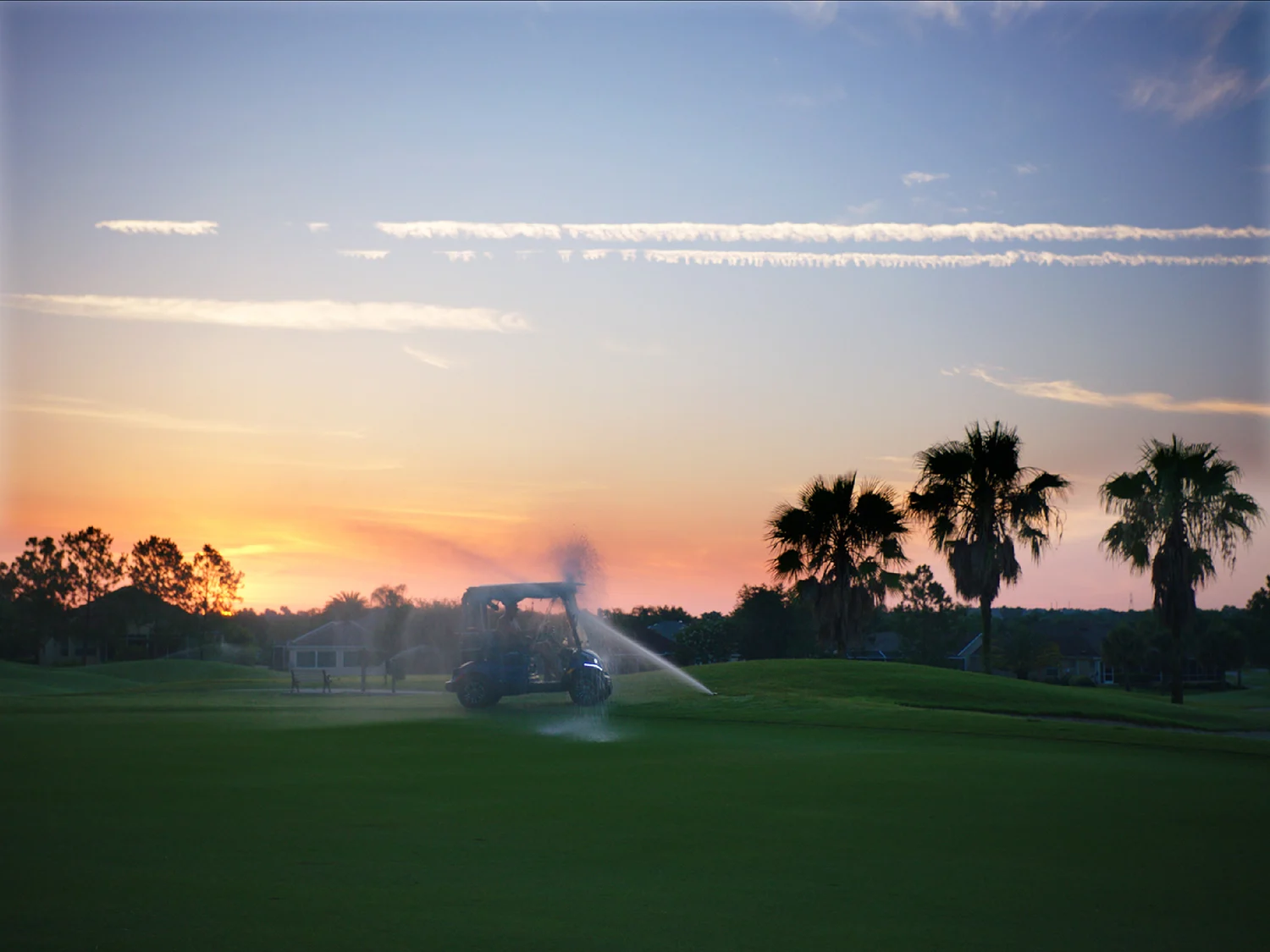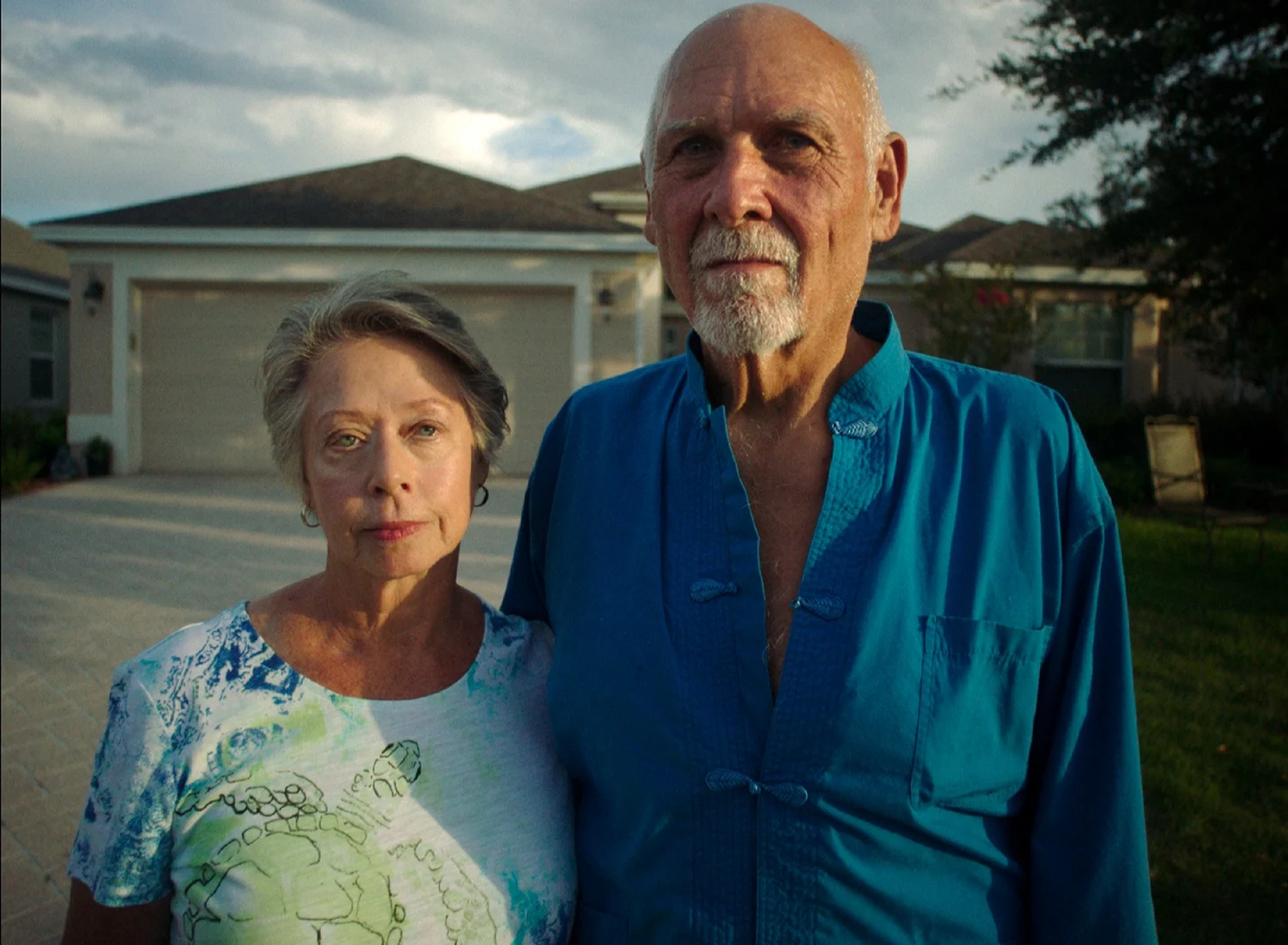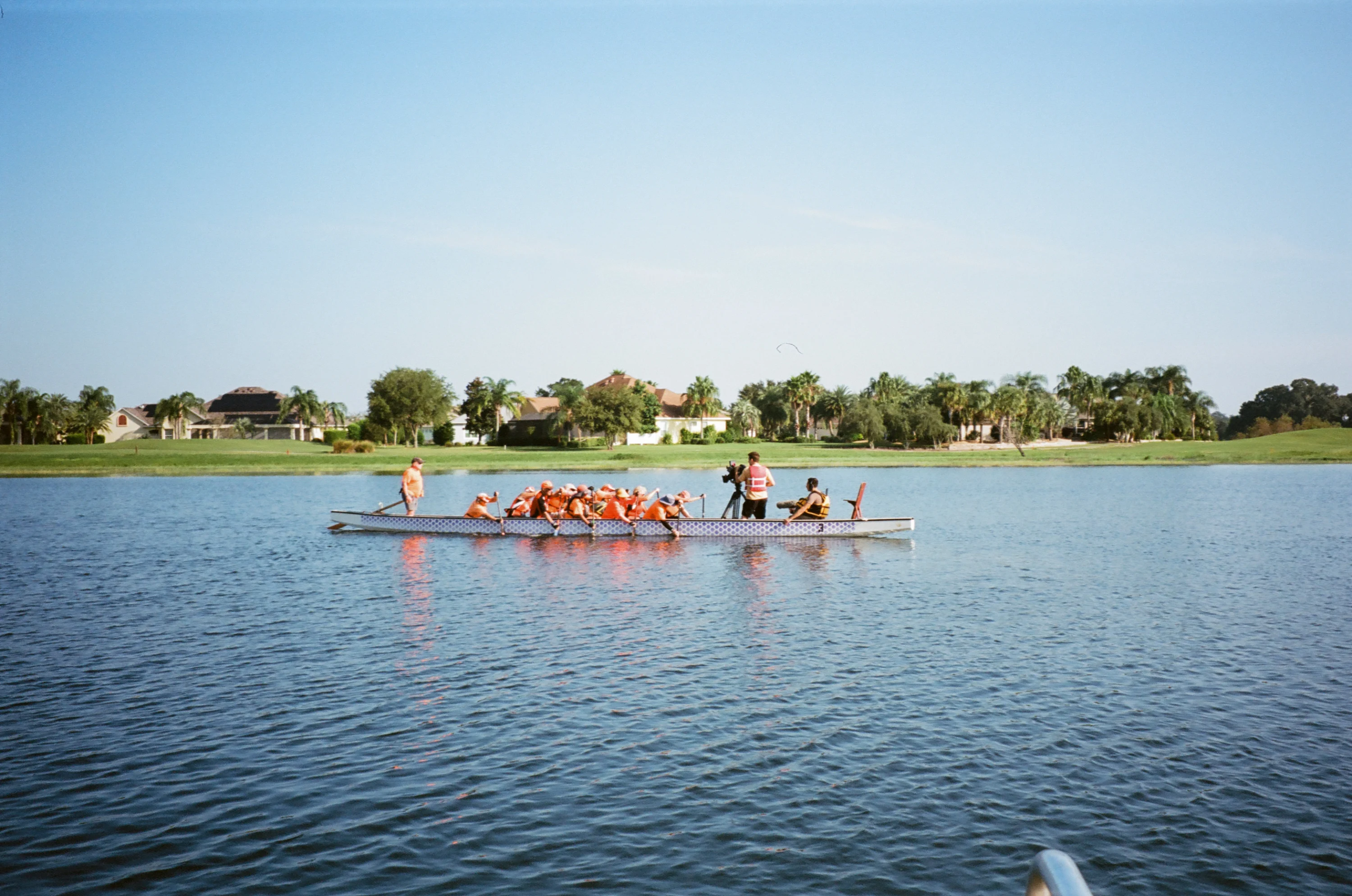
Known as the “Disney World for retirees” Florida’s gated community The Villages has been a beacon of curiosity and gossip since it opened in the late 1980s, attracting as many intrepid reporters as residents looking to settle down in the Sunshine State. In his debut feature-length documentary, fellow Floridian and filmmaker Lance Oppenheim peels back the veneer to get to the heart of the stories of the people who call The Villages home. Ahead of its release writer we dive into the process behind Lance’s hyperreal fantasy project.
Just as Belinda Carlisle was singing about heaven being a place on earth in the late 1980s, Harold Schwartz and his son Harold Gary Morse were busy building their own version of one in central Florida. Morse had moved to the Sunshine State a few years before to help with the family business of selling empty lots to mobile home owners. That initiative wasn’t really working out, so the pair instead took a chance and ventured into property development, creating the gated community that is today known as The Villages. And that idea did work out – big time. By the end of the decade they were selling over 500 homes a year, mainly to retirees and those looking to live out the remainder of their years in the sun-kissed bliss. Instead of creating a space that looked modern and new, the residential properties took on the image of a picture-perfect-white-picket American hometown, one steeped in nostalgia that could evoke the feeling of a distant memory in prospective residents – despite them never having actually lived there. Throw in golf courses, tennis courts, kayaking, art classes, acting clubs, synchronized swimming – you name it – and it wasn’t long until both Floridians and the media alike had dubbed The Villages “Disney World for retirees.” “Our Villagers moved here because they found the fountain of youth,” Schwartz proudly proclaims in one of the early video adverts for the place.

Today, “Florida's Friendliest Hometown” – as The Villages advertise themselves – is larger in square mileage than Manhattan, spanning three counties with a population of around 130,000 residents. For the past few years, the area has been recognized as one of the fastest growing metropolitan districts in the United States. And it’s not just its size that has garnered column inches. The Villagers’ escapades themselves have proved juicy tabloid fodder throughout its relatively short history. The New York Post famously reported on the rising rates of STDs amongst residents, with dedicated forums, conspiracy theories, unauthorized oral histories and curious documentarists also vying for their own opportunity to debunk the myths and absurdities that lie within those white gates over the years.
Born about 225 miles southeast of the Villages, 23-year-old filmmaker Lance Oppenheim, just like his fellow Floridians, spent most of his life reading about the place and hearing various salacious stories. “On a slow news day, there would always be headlines about reporters sneaking their way into there,” he remembers. Growing up, his mother would cut out compelling stories from the local newspapers which served as the basis for Lance's early work, and although The Villages proved a constant source of fascination to him, it wasn’t until his final year of studying filmmaking at Harvard that he finally decided to pursue his own interpretation of the sunny pleasantville. Lance had previously released short documentaries (three of them being Op-Docs produced by The New York Times), but with the Villages wanted to make a piece that created a different picture than the seedy, hyper-sexualized one that the area had fallen victim to. But to begin with, things didn’t quite go to plan.
“I was denied access to all the areas and institutions that I wanted to shoot at – a lot of those places wouldn’t let me film, or at least let me film the things I was interested in exploring,” he says. So Lance did what any curious and dedicated documentary maker would do; he moved to The Villages prior to filming for 28 days in order to meet people and experience what it really feels like to live inside the haven.
“I’ve grown up around a lot of retirement communities so being at a place like the Villages didn’t feel so foreign to me,” says Lance, who spent most of that initial period scouting locations and subjects. One of the first places he visited was the acting club. “I thought if there were any folks that were willing to talk to me it would be the people who were most comfortable with performing,” he adds. But despite being one of the youngest residents, he quickly noticed there was something different in the mindset of residents compared with any other similar places he’d been before. “When I was talking to people, I realized that the hallmarks that people usually care about like age or career don’t matter. All that matters is the now.”
Our Villagers moved here because they found the fountain of youth.
Becoming part of the community resulted in Lance having a clearer idea of the direction he wanted to take with his film. “I wanted to make a documentary that was focused on the people. One that explored the dreams, the fantasies and the unfulfilled desires of people who lived there. No matter where you live – even if you’re in a fantasy world – you’re still going to have to deal with the same shit and be as much of a hot mess as you would be anywhere else.” Eighteen months later, Some Kind of Heaven was born. The film premiered at Sundance festival in January 2020, making it Lance’s first feature-length documentary to do so, but also the first of its genre to be produced by director Darren Aronofsky’s production company Protozoa Pictures.
The magic of Some Kind of Heaven lies within its casting, and early on that became the most crucial part of building the plot of Lance’s cinematic postcard. Lance and his team quickly recognized it was going to be impossible to tell the full story of The Villages’ history, so instead he focused on finding subjects who were willing to allow cameras into their micro universes that make up the puzzle of the place. Over four filming visits, 30 subjects were whittled down to four main personalities that each contributed their individual stories to the big picture.




There’s Anne and Reggie Kincer, a married couple continuing to overcome challenges in their relationship which has been 47 years in the making. There’s Barbara Lochiatto, a recently widowed uber-charismatic Bostonian with a knack for tragi-comic delivery. And then there’s Dennis Dean, a serial bachelor who lives in his illegally parked van trying to juggle his inner need for staying single with the benefits of partnering up with someone who has a static home. While their stories never cross paths in the 82 minutes, this foursome represents a set of archetypes. “These are the people that I connected to the most,” Lance says of his choices. “They appreciated us as much as we appreciated them, and the level of trust and love went far beyond just what you see on the screen.” In fact, their friendships have continued and Lance continues to have weekly calls with all four of his film’s subjects.
We’re living in the golden age of documentaries. The likes of Tiger King, Don’t Mess With Cats and Fyre all garnered internet fame within days of their release and the audience's appetite for real stories that sound like made-up ones doesn’t show any signs of slowing down. But what Some Kind of Heaven does differently is that it never judges or sneers at its protagonists. The film opens with a sequence of surreal scenes setting up The Villages as the colorful nirvana it advertises itself to be. There’s synchronized golf cart performances, elderly cheerleaders, marching band rehearsals and wild neon-lit raves. The dream-like qualities of these scenarios are heightened with Lance’s highly cinematic, almost lurid style, and developed with the help of director of photography David Bolen who aptly references artist Larry Sultan and his Pictures from Home series.
But the perfection of Some Kind of Heaven’s tableaux vivants is quickly broken down when juxtaposed against the everyday trials and tribulations Barbara, Dennis, Anne and Reggie are faced with, situations you might never expect to exist in such a seemingly happy place. “The thing that makes all three storylines that you’re toggling between is that they’re all about love and how to be in a relationship,” explains Lance.
While Anne and Reggie are in constant dialogue about how his choice of using hallucinogens is affecting their marriage, we follow Dennis through different stages of his housing sagas and watch how his priorities shift. But it’s Barbara’s highly internalized story that garners the most emotional reaction in Some Kind of Heaven. She moved to The Villages in 2003 with her then-husband Paul after doing two “lifestyle preview” trips which included a week in the community with reduced fees on services, such as cinema tickets, golf carts and tennis courts. “At that time, it was really a dream land and we fell in love with the place,” Barbara says. But soon after they moved there, she experienced a culture shock as the reality of the Floridian communities she was surrounded by began to sink in, many with mindsets quite different to hers. “It has never been America’s friendliest hometown and I realized that after a couple of months of living here,” she says.
That’s what’s most interesting about the place – age doesn’t really matter there.
Later in the film though, Barbara does find a semblance of that promised Villages magic. A lifelong lover of the stage, she tells the audience that she has dreamed of becoming an actress since she was a child, and that dream, decades later, has yet to be dampened. “If there’s one thing I’m confident in it’s that. I just have it bursting out of me,” she says. And in the film’s emotional climax, she gets her own moment in the sun, performing a version of Jessica Lange’s monologue from American Horror Story Asylum to the audience of The Villages’ acting club. “When it came to seeing it for the first time, for a split second I wondered: ‘wait, who is this?’ And then I realized it was me. I guess I thought I was kinda good.”
Instead of being obsessed with the absolute truth, Lance revels in walking that thin line between reality and performance throughout Some Kind of Heaven. “Rather than stealing moments through hours of fly-on-the-wall observation, we invited Anne, Reggie, Barbara, and Dennis into our process,” he says. “We didn’t shy away from asking difficult questions, and instead described our intentions and detailed what we found interesting in their stories. Knowing what the lens of the production was, they almost treated their appearance in the film as a performance – one in which they were enacting difficult moments from their everyday lives. At times, it felt like we were shooting some kind of art-house reality TV episode. Now I don’t think I’d want to film a documentary in any other way.”
When it came to getting Some Kind of Heaven out into the world, Lance and his team were aiming for a theatrical release. “That’s the ideal way to experience a movie, rather than pausing it, going to the bathroom and pulling up a Buzzfeed article written about the place that’s got nothing to do with it,” he says of our current fragmented way of consuming. But higher powers had something else in plan. Due to the COVID-19 outbreak, the distribution of the film is awaiting a rethink, its theme perhaps more poignant than ever.
While the focus of Some Kind of Heaven might be on telling the stories of people in the winters of their lives, it erases any generational differences that might be part of the wider social consciousness. In all its ridiculous imperfection, The Villages represent hope for all of us. “The choices that they’re making are no different from the choices that I’m making now,” Lance says. “I kind of found that to be both terrifying but also quite hopeful. That’s what’s most interesting about the place: age doesn’t really matter there.”
Some Kind of Heaven will be released by Magnolia Pictures in early 2021

